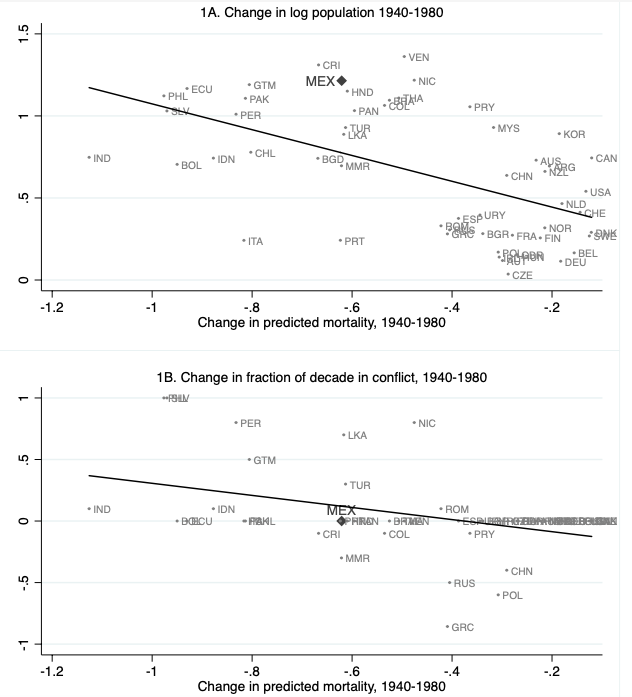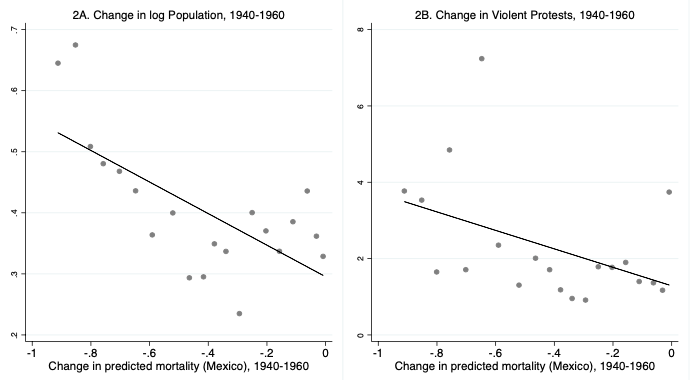
Population surges tend to cause conflict and competition for resources if unaccompanied by productivity growth and unmediated by strong institutions
The global population is projected to exceed 10 billion by 2100. This 50% increase, as well as ongoing climate change, are likely to exacerbate the demand for natural resources. An often ignored consequence might be greater conflict, especially since much of the population growth and adverse effects of climate change will take place in areas with weak institutions and myriad economic, social, and legal problems.
Population pressure and conflict
Fears that population pressure may cause violent conflict are not new and date back at least to Malthus (1798). Several authors have argued that increases in population can lead to conflict, particularly if combined with resource scarcity and when the state has limited capacity to manage dissent (e.g. Diehl and Gleditsch 2001, Goldstone 1991, 2002, Goldstone et al. 2012, Hauge and Ellingsen 1998, Homer-Dixon, 1991, 1999, Tir and Diehl 1998, Urdal, 2005). However, others disagree (e.g. Richards 1996).
Consensus has been hard to come by because the positive empirical association between population and violence does not prove that population causes conflict. Instead, it may reflect that population correlates with other characteristics causing violence, or that violence influences population growth through its effects on mortality and fertility.
For sub-Saharan Africa, Brückner (2010) proposes using variation in population growth caused by randomly occurring droughts as a solution to this empirical challenge. He finds that a 5% increase in population size raises the risk of civil conflict by around six percentage points. However, it is hard to extrapolate these findings to other settings and we lack clear evidence on the likely mechanisms involved.
The study: The international epidemiological transition
In a study, forthcoming in the Review of Economic Studies (Acemoglu et al. in press), we study the effect of population growth on conflict in a panel of over countries 60 countries from various regions in the world. To delve deeper into the mechanisms at play, we also complement the analysis with variation from Mexico.
Our approach focuses on the international epidemiological transition starting in the 1940s, when — largely due to the introduction of new drugs, chemicals, and public health measures —many countries experienced better health longevity, and consequently, more rapid population growth. Most of these breakthroughs originated in a few industrialised countries and can reasonably be considered unrelated to the conflict prospects in the rest of the world. Therefore, we exploit that countries where the initial mortality burden from these diseases was highest should have experienced more rapid population growth.
The findings: Disease mortality, population, and conflict
Such expectation is confirmed in the data, as shown in Figure 1A. The horizontal axis measures each country’s expected fall in mortality from these diseases as implied by the best practices introduced since the 1940s (a variable we term ‘predicted mortality’). The vertical axis looks at the corresponding change in the logarithm of population.
From 1940 to 1980, our baseline period of analysis, countries with the biggest drops in predicted mortality induced by the international transition had the largest increases in population. More interestingly, as shown in Figure 1B, these changes in predicted mortality increased conflict, measured by the fraction of years per decade that each country experienced a civil war.
Moreover, these diverging patterns only arise since the 1940s, and do not reflect any previous differences that might have affected subsequent population or conflict patterns in countries with different disease environments. In our study, we observe no relation between preceding population growth or changes in conflict (1900-1940) and the changes in predicted mortality.
Figure 1 Larger increases in population and conflict in countries with larger expected falls in disease mortality

Source: Acemoglu et al. (in press).
Note: Points represent countries.
The effect of population increase on social conflict is sizeable. Our estimations imply that the average change in population in our sample of countries caused roughly 4.2 additional years of full-blown civil war in the 1980s relative to the 1940s.
However, the question remains whether these findings reflect a ‘Malthusian’ channel, where growth in population unaccompanied by improved productivity or economic opportunities intensifies conflict over scarce resources. Complementary results suggest they do. We show that population growth increased conflict related to natural resources but had no effect on conflicts unrelated to natural resources, and that they raise conflict in slowly growing — but not in rapidly growing — countries.
Further analysis: Malaria mortality in Mexico
To examine this question in more detail and to explore implications for conflicts beyond civil wars, we also study population growth and its effect on violent protests in Mexico. As in our cross-country study, we focus on differential changes in mortality across municipalities. In this case, we look at malaria mortality specifically.
Mexican municipalities experienced substantial differences in malaria mortality due to differences in climate and geography. Starting in the 1940s, as part of the broader international epidemiological transition, Mexico embarked upon an ambitious anti-malarial campaign. These efforts quickly brought down morbidity and mortality rates from malaria, especially in more malaria-prone areas.
Figure 2A reveals that the population increased more where malaria mortality decreased more. These changes increased violent protests, as shown in Figure 2B. Our estimations imply that the average change in population in our sample created 5.35 more protests per hundred thousand inhabitants (a large increase relative to the mean of 2.3).
Figure 2 Larger increases in population and conflict in Mexican municipalities with larger expected falls in malaria mortality

Source: Acemoglu et al. (in press).
Note: Points represent municipal averages within equal-size bins.
Access to natural resources: Protests and drought
Consistent with our Malthusian interpretation, increases in violent protests are driven by those related to natural resources. Moreover, protests were more pronounced when there was also economic hardship in the form of droughts. As in our cross-country analysis, we verify that the results in Mexico do not reflect other pre-existing differences between municipalities or other correlated variables.
Also, to confirm that droughts are not capturing other differences in municipalities that are more drought-prone, we build a drought measure that takes into account each municipality’s weather seasonality. We confirm that only droughts occurring during the months that matter for crop productivity exacerbate the impact of population growth.
Implications: Productivity growth and strong institutions are crucial
Overall, these results imply that population surges tend to cause conflict and competition for scarce resources is part of the reason. But these results should not be read as suggesting that population growth always contributes to conflict. It does so when it is unaccompanied by productivity growth (which would provide other economic opportunities) and when it is unmediated by strong institutions.
Our work therefore suggests that measures to support economic growth and strengthen institutions in some of the most vulnerable parts of the world are of paramount importance, not only for the usual welfare benefits they would generate, but also because they are necessary for enabling better adaptation to population growth and the demand for resources this generates.
References
Acemoglu, D, L Fergusson and S Johnson (in press), “Population and Conflict”, Review of Economic Studies.
Diehl, P F and N P Gleditsch (2001), Environmental Conflict, Boulder, CO: Westview Press.
Goldstone, J (1991), Revolution and Rebellion in the Early Modern World, Oakland, CA: University of California Press.
Goldstone, J (2002), “Population and Security: How Demographic Change can Lead to Violent Conflict,” Journal of International Affairs 56: 3–21.
Goldstone, J, E Kaufmann and M Toft (2012), Political Demography: How Population Changes are Reshaping International Security and National Politics, Oxford: Oxford University Press.
Hauge, W and T Ellingsen (1998), “Beyond Environmental Scarcity: Causal Pathways to Conflict,” Journal of Peace Research 35: 299–317.
Homer-Dixon, T F (1991), “On the Threshold: Environmental Changes as Causes of Acute Conflict,” International Security 2: 76–116.
Homer-Dixon, T F (1999), Environment, Scarcity and Violence, Princeton, NJ: Princeton University Press.
Malthus, T R (1798), An Essay on the Principle of Population, As IT Affects the Future Improvement of Society: With Remarks on the Speculations of Mr. Godwin, M. Condorcet and Other Writers, London: Printed for J. John.
Tir, J and P F Diehl (1998), “Demographic Pressure and Interstate Conflict: Linking Population Growth and Density to Militarized Disputes and Wars, 1930–89”, Journal of Peace Research 35: 319–339.
Urdal, H (2005), “People vs. Malthus: Population Pressures, Environmental Degradation and Armed Conflict Revisited,” Journal of Peace Research 42: 417–434.



